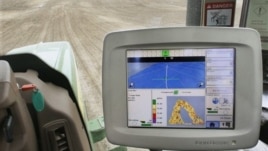 |
| A GPS unit inside a tractor on a farm in Tallula, Illinois |
Precision agriculture is a way of thinking about how to improve production and get more from existing resources. It often involves the use of technology. An example found mostly in wealthier countries is a computer-guided tractor. The computer does most of the driving. It uses signals from satellites in the Global Positioning System. GPS technology helps the tractor cut rows in straight lines and put the right amount of fertilizer in the right place.
(SOUND)
Jimmy Messick is a farmer in northern Virginia, not far from Washington. He says the GPS guidance system makes it easy to come back later and plant the seed in his fields of maize, or corn.
JIMMY MESSICK: "Because the tractor that's pulling the planter also has the same auto-guidance system in it as the tractor that applied the fertilizer and did this tillage, it will come back and put the seed right on top of these marks."
Because of the GPS guidance, Mr. Messick now pays half what he once did for fertilizer.
Bruce Erickson is an agronomist at Purdue University in Indiana. He says saving even a little bit of seed, pesticide or fertilizer "computes directly to cost savings and less environmental damage."
Raj Khosla is an agronomist at Colorado State University. He says farmers in the developing world can use precision agriculture even without high-tech tractors.
RAJ KHOSLA: "We do not necessarily have to have complex, large machinery to practice what could be done as [simply] as using bottle caps."
The idea is to use a bottle cap to pour a measured amount of fertilizer right next to each plant. It takes more work than simply throwing handfuls of fertilizer across a field.
But Mr. Khosla says researchers taught this bottle cap method to farmers in sub-Saharan Africa. They discovered that it was worth the extra effort if they could only afford a small amount of fertilizer.
RAJ KHOSLA: "There was a huge difference: more than double, in terms of productivity."
Of course, new technology is not always so cheap. But Mr. Khosla says farmers could form a cooperative or combine their resources to pay for new equipment. He and other researchers worked with a farmer in India to precision-level his irrigated wheat fields. That kept the fields from developing wet and dry areas that reduced productivity. The farmer also added better fertilizers and insect control.
As a result, he was able to grow almost three times as much wheat on the same amount of land. Mr. Khosla says with the extra money the farmer made, and a small loan, he bought his own precision leveler. And now, for a fee, he offers that as a service to his neighbors and other farmers.
And that's the VOA Special English Agriculture Report. I'm Jim Tedder.
Original Article Here

No comments:
Post a Comment